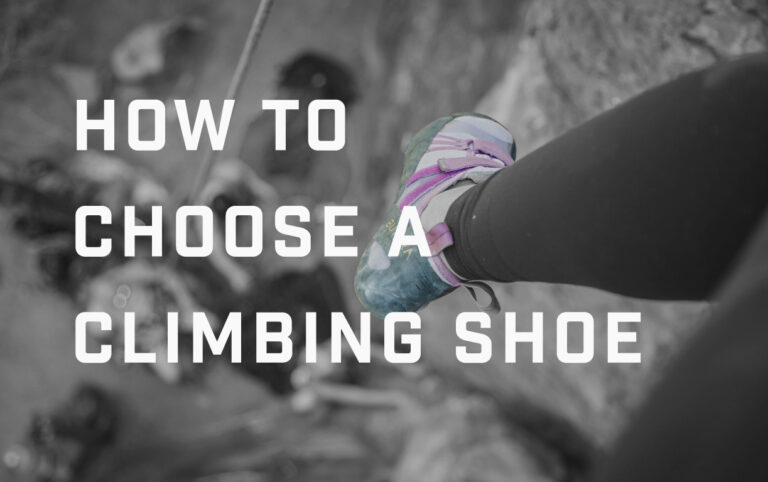Have you ever wondered what all those numbers and symbols mean on your brand new climbing rope label?
You are not alone.
Most us, even long-time climbers, don’t know what all the mumbo-jumbo really means.
We may know what type of rope we want–Single, Twin, or Half/Double–and what length we need. But climbing labels, like climbing ratings, can be confusing.
Who really reads label anyway, right?
Still, we hang our lives on these ropes every single time we tie in, shouldn’t we at least understand what they’re trying to tell us?
Once you’ve read through and learned the basics of rope labels and safety, get a climbing rope bag to keep your rope clean and safe or wash it to refresh its staying power.
Climbing Rope Labels Explained By The Numbers
Whether you are researching ropes online or in the store, climbing rope labels usually look something like this:
Searching online, the specifications may also look something like this:

Minimum physical product label standards can differ from place to place, but companies generally provide full details in their online product specs.
We are going to follow along with the product labels shown above: A Sterling Aero 9.2mm Single rope and the online specifications listed by Petzl for their Rumba 8mm Half rope.
Diameter & Length
Diameter and length are pretty straightforward parameters.
The diameter is the distance across a given section of rope.

Diameter is synonymous with thickness is this case. The rope thickness you choose will depend on how you intend to use it.
New technology is offering Multi-use ropes that are certified for multiple uses with one diameter. A great example is the Edelrid Canary Pro Dy.
If you are interested in the actual rope making process, check out this article and some interesting videos showing each step.
For the most part, thicker ropes are Single ropes and thinner ropes are double or Twin ropes (always check the label to be sure).
Length, is well, length.
Standard length used to be 60 meters. Today you can get ropes up to 100 meters.
UIAA, CE, EN
All ropes will need to be marked with the following certification standards to ensure safety.
Some ropes have markings on the label or tag, some on the tip of the rope in a circular plastic label, and more frequently on a heat transfer label like the Mammut rope below.
UIAA
UIAA stands for Union Internationale des Associations d’Alpinisme (UIAA). Translated that is The International Climbing and Mountaineering Federation.
The UIAA is a Swiss-based organization founded in 1932 to, “promote(s) the growth and protection of mountaineering worldwide.”
They are responsible for setting the safety standards for climbing equipment and issuing safety certification for each piece of equipment.
Ropes will usually list a UIAA fall rating. This is based on a standardized test with controlled factor falls of ~1.7 until breakage.
As the name implies, UIAA is an international organization.
This means the board determining the safety standards is made up of people from all over the world; giving the UIAA a more broad outlook on the sport and a keener eye on global safety needs.
Surprisingly, UIAA certification is not required by manufacturers. However, the UIAA safety standards are the most stringent of certifications.
Reputable manufacturers opt to meet or exceed UIAA standards and it is not recommended to purchase gear–especially ropes or harnesses–that have not met these requirements.
Short and sweet: UIAA ensures your safety. Make sure your gear has their seal of approval.
You can learn more about the UIAA’s safety standards and rope testing procedures specifically on their website.
CE
CE stands for Conformité Européenne and is the European safety conformity standard for all goods sold in Europe.
The European Economic Community establishes standards for products sold within the European Union.
CE certifications can be found on a number of products from blenders to climbing gear.
Products not sold in Europe do not have to meet CE standards. Most climbing gear has the CE because it is sold in Europe.
Still, the UIAA logo implies a much higher level of safety testing.
As far as climbing gear standards go, the CE certifies products that meet their standards. However, they do not create the standards.
Safety standards for climbing equipment are created by the UIAA.
The minimum to be awarded CE certification is much lower than what it takes to meet UIAA standards.
Next to ‘CE’ you will find a 4 digit number. This is the certificate number of the CE safety standards that particular product has complied with.
EN
EN stands for European Standards or European Norm.
This is an agreed-upon safety standard for a specific product.
For dynamic rock climbing ropes this standard is indicated by the number 892.

The test to determine whether a piece of equipment meets this standard is created by the UIAA.
UIAA is an international organization while EN is a European organization.
A dynamic rope will go through one test which both the EN and UIAA agree upon for their standards.
If the rope passes the test, the EN gives the rope a European seal of approval and the UIAA gives it International approval—EN 892 and UIAA 101 respectively.
Basically, different labels for the same standard.
Here is an infographic from the UIAA showing the testing standard used for dynamic climbing ropes.
As you can see in the upper headings, both the EN and UIAA have agreed upon the same test.

Confusing?
We know. It took us a while to figure it out too.
As, just about every climber ever has said at least once, “These ropes are a real cluster f*ck.”
For the redpoint: Summary of UIAA vs. CE vs. EN
- UIAA is an international organization focused on mountaineering and climbing pursuits.
- Their safety standards are the highest when it comes to climbing gear.
- CE stands for Conformity Europeenne and is the European safety conformity standard for all goods sold in Europe.
- To meet CE requirements a product must comply with EN technical and/or safety standards.
- The EN/UIAA tests for dynamic climbing ropes are EN 892 and UIAA 101. These will be indicated on your rope label and the markings at the ends of your rope.
Rope Type
Phew! Now that is out of the way we can move on to the big stuff.
As mentioned in a previous article, rope types for dynamic rock climbing ropes are indicated by 3 symbols:

The number 1 in a circle indicates a rope for Single use.
1/2 indicates a rope to be used as a Half or Double rope.
Two intersecting circles, like a ven diagram, indicate a rope for use as a Twin rope.
A rope may be certified and labelled with one or all three of these symbols.
This may be shown in a few different ways depending on where you are finding your information:

Weight Per Meter
Rope weight is generally given in weight per meter instead of overall weight.
This factor is dependent upon material and sheath percentage.
Most Single-use dynamic ropes will be in the 3.8 kg/8.5 lb. range.
Percentage of Sheath
The sheath is the braided outer shell that protects the core of your rope.
Sheath percentage usually ranges from ~30-40%.
This percentage is a proportion of the overall mass of a rope.
As a general rule, the higher the sheath percentage, the more resistant it is to abrasion or wear and tear. And, the higher the sheath percentage, the thicker the diameter.
A rope’s sheath accounts for ~20% of its weight-bearing strength compared to the core which accounts for ~80% of rope strength.
Number of Factor Falls
This is where the EN 892 or UIAA 101 comes in (as shown in the infographic above).
When a rope is manufactured, it is made in one very long piece hundreds of meters in length.
A sample of that rope is cut and sent for testing.
The standardized EN 892/UIAA 101 test is performed. When the results are issued the rope manufacturer can then label that piece of rope with the corresponding certification.
To pass, the rope must withstand a minimum of 5 simulated falls without breaking.
The ratings given on rope labels indicate the number of falls it took before this rope broke in the simulated fall test.

You can see the full details of the test here.
So, a higher ‘Number of falls’ could indicate a stronger rope.
Note: Different types of ropes are tested differently. For example, the minimum falls allowed for a Single rope before breakage are 5. While the minimum for a Twin Rope is 12.
Meaning, higher number of falls on a label doesn’t 100% imply a stronger rope if you are looking at two different types of ropes.
Familiarize yourself with the specific tests standards for each type of rope.
Static Elongation
This is a measurement of how much the rope stretches when weighted without a fall.
For example, when you hang on top rope. Not a fall, just hanging.
Acceptable static elongation for a Single-use dynamic climbing rope is less than or equal to 10%.
This is most important when you are talking about potential ground falls right off the deck.
Dynamic Elongation
This measurement indicates the amount of rope stretch with a weighted fall.
Acceptable dynamic elongation for a Single-use dynamic rope is less than or equal to 40%.
Part of what makes a rope ‘dynamic’ is its ability to stretch and recoil.
This stretch reduces the impact force of a fall. Essentially, reducing the force placed on your piece of protection whether that is a bolt or a wobbly cam.
For this reason, dynamic climbing ropes are much safer for climbing where falls are imminent.
For example, as you can see in the image below from Tendon Ropes, the blue rope has a dynamic elongation of 32% with a max impact force of 8.6 kN.
Whereas the lower yellow bi-color rope has a dynamic elongation of 40% but a much lower max impact force of 7 kN.
How you choose which rope is better for you will depend on the type of climbing you are doing and the terrain you will be climbing in.
Impact Force
As you can see above, impact force can change based on rope construction and purpose.
The maximum acceptable impact force for a Single-use dynamic climbing rope is less than or equal to 12 kN.
1 Kilonewton (kN) is equivalent to the force due to gravity that 100 kg of mass will exert on the earth.
So, 12 kN would be equivalent to ~2700 lbs. of force.
It is not necessary to know what a Kilonewton (kN) is. Just know that it is a measure of force and 12 kN’s is a lot more than any person’s bodyweight.
Again, the UIAA testing standards are severe. Generating this much force in a real-life climbing situation would be rare if not difficult.
Sheath Slippage
This parameter is not always mentioned on manufacturer labels.
However, it can be an important consideration. Sheath slippage can significantly impact the performance and safety of your rope.
UIAA standards for sheath slippage are less than or equal to 20mm of slippage after 5 pulls of the rope.
Because less sheath slippage means a better performing rope, modern climbing rope manufacturers are finding new ways to reduce slippage.
Tendon ropes have a proprietary process for reducing sheath slippage to practically nothing and they make it clear for all their ropes.
Summary
UIAA stands for Union Internationale des Associations d’Alpinisme or The International Climbing and Mountaineering Federation. The UIAA sets international safety standards for climbing and mountaineering equipment.
UIAA fall rating is the number of falls a section of rope can withstand before breaking during a standardized UIAA test. The minimum number of acceptable falls before breakage for a Single-use dynamic climbing rope is 5, for Half or Double dynamic ropes it is also 5, for a Twin dynamic rope the minimum number is 12 falls. UIAA falls listed on climbing rope labels indicate the number of falls that rope withstood during the standard UIAA test before breakage.
CE stands for Conformity Europeenne and is the European safety conformity standard set out by the The European Economic Community to establish safety standards for products sold within the European Union.
When seen on climbing ropes or other products, EN stands for European Norm. Often, on rock climbing ropes the EN will be accompanied by the numbers 892. These numbers indicate the safety test which the product passed to receive the EN certification.
Ropes Make Climbing Fun and Safe
It is important to understand the standards that go into creating high-performance rock climbing ropes.
Hopefully, this guide has helped clear up some of the confusion encountered when looking at climbing rope labels and specifications.
Did we miss anything?
What do you think is the most important factor when it comes to choosing a climbing rope?







